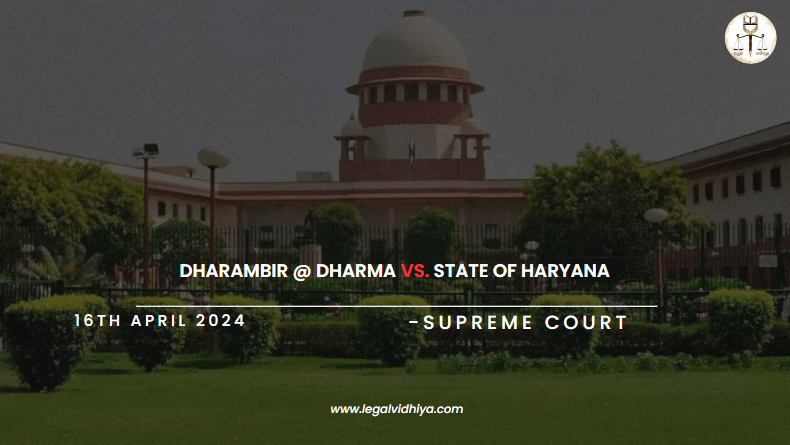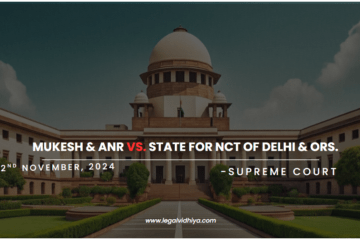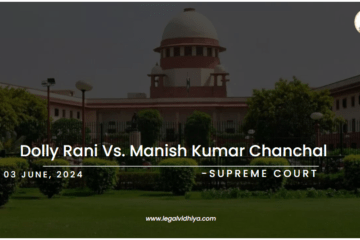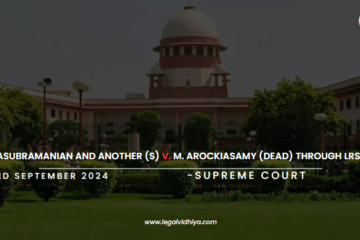
| CITATION | 2024 INSC 307 |
| DATE OF JUDGMENT | 16th April 2024 |
| COURT | Supreme Court of India |
| APPELLANT | Dharambir @ Dharma |
| RESPONDENT | State of Haryana |
| BENCH | Justice B.R. Gavai, Justice Sandeep Mehta |
INTRODUCTION
The case of Dharambir @ Dharma vs. State of Haryana pertains to the conviction and sentencing of the appellant for the murder of Karambir under Section 302 of the Indian Penal Code. The Sessions Judge, Bhiwani, had convicted Dharambir and sentenced him to life imprisonment along with a fine. This decision was upheld by the High Court of Punjab and Haryana, leading to the current appeal before the Supreme Court. The case revolves around the reliability of eyewitness testimonies, the alleged motive for the murder, and the validity of the confession made by the appellant.
FACTS OF THE CASE
- Karambir, his brother Krishan Kumar (PW-5), Ravinder (PW-6), Mahender (PW-7), and two acquaintances went to Prabhat Cinema in Bhiwani. The accused stabbed Karambir in the chest, causing his immediate death, and then fled the scene, leaving the knife behind. The motive was the accused’s suspicion of Karambir’s involvement with his wife.
- Inspector Rohtas Singh (PW-11) received a call from Raj Kumar (PW-9), the cinema manager, and arrived at the scene with other police personnel. Krishan Kumar’s statement (Exhibit-PF) was recorded, leading to the registration of FIR No. 309 of 1998 for murder under Section 302 IPC.
- Rohtas Singh (PW-11) conducted the investigation, which included inspecting the scene, preparing the inquest report, seizing the knife, making a site plan, recording witness statements, and sending Karambir’s body for a post-mortem.
- Dr. Hemant Singh (PW-1) performed the autopsy, noting two incised wounds and concluding that shock and hemorrhage from the abdominal injury caused Karambir’s death. He issued the post-mortem report (Ex.-PA).
- The accused was arrested and charged with murder under Section 302 IPC. The case was committed to the Sessions Court, where the accused denied the charges and stood trial.
- The prosecution presented 11 witnesses, focusing on the testimonies of Krishan Kumar (PW-5) and Ram Kumar (PW-8), who testified about an extra-judicial confession by the accused.
- The accused, questioned under Section 313 of the CrPC, denied the allegations and claimed innocence. One defense witness, Piare Lal (DW-1), was examined.
- The trial court convicted and sentenced the accused to life imprisonment. The High Court upheld this decision. The current appeal challenges this judgment.
ISSUES RAISED
- Whether the prosecution witnesses, especially Krishan Kumar (PW-5) and Ram Kumar (PW-8), who claimed to have witnessed the crime and heard an extra judicial confession respectively, are reliable?
CONTENTIONS OF APPEALENT
- The appellant contended that the evidence of the key prosecution witness, Krishan Kumar (PW-5), was unreliable. The appellant argued that Krishan Kumar made significant improvements from his earlier statement (Exhibit-PF) based on which the FIR was registered, and the timings mentioned by Krishan Kumar did not align with those provided by Raj Kumar (PW-9), the Manager of Prabhat Cinema.
- The appellant further argued that Krishan Kumar’s claim of being present at the crime scene was questionable since he had no bloodstains on his clothes, which would have been expected if he had attempted to help his brother.
- The appellant pointed out contradictions between Krishan Kumar’s testimony and that of Raj Kumar (PW-9) regarding the seating arrangement and the sequence of events.
- The appellant also noted that two key witnesses, Ravinder (PW-6) and Mahender (PW-7), who were present at the scene, did not support the prosecution’s case and were declared hostile.
- The appellant challenged the credibility of the extra-judicial confession allegedly made to Ram Kumar (PW-8), arguing that Ram Kumar was a close relative of the deceased and thus could not be considered impartial. Furthermore, Piare Lal (DW-1), who was supposed to have been present during the confession, denied that such a confession took place.
- The appellant concluded that Krishan Kumar (PW-5) was a wholly unreliable witness, and since Ram Kumar’s (PW-8) testimony was also contradicted, there was no substantial evidence to uphold the conviction.
CONTENTIONS OF REPONDENT
- The respondent argued that the testimony of Krishan Kumar (PW-5), being the deceased’s brother, was natural and credible. They asserted that there was no reason for him to falsely implicate the appellant, who was closely related to both the deceased and the witness.
- The respondent contended that Ram Kumar (PW-8), the ex-Sarpanch, provided a convincing account of the extra-judicial confession made by the appellant, which corroborated Krishan Kumar’s (PW-5) testimony.
- They highlighted that the prosecution had established a motive, as the appellant suspected the deceased of having an illicit relationship with his wife, which provided a plausible reason for the crime.
- The respondent maintained that the trial court and the High Court had correctly appreciated the evidence and found no reason to interfere with their concurrent findings.
JUDGEMENT
The Supreme Court, after thoroughly examining the evidence and arguments presented, concluded that the prosecution failed to establish the guilt of Dharambir beyond a reasonable doubt. The Court noted significant inconsistencies and contradictions in the testimonies of key witnesses and the lack of credible corroborative evidence. Consequently, the Court acquitted Dharambir, overturning the convictions and sentences imposed by the trial court and the High Court. Dharambir was granted the benefit of the doubt, and his bail bonds were discharged.
ANALYSIS
The Supreme Court’s decision to acquit Dharambir was based on several key factors. The Court found Krishan Kumar (PW-5) to be an unreliable witness due to substantial contradictions between his initial statement and his testimony in court. His failure to produce the cinema ticket and the lack of blood stains on his clothes further questioned his presence at the crime scene. Additionally, there were significant discrepancies regarding the seating arrangements and the timing of the incident, with Raj Kumar’s (PW-9) testimony conflicting with Krishan Kumar’s (PW-5) account, undermining the prosecution’s narrative. The alleged extra judicial confession to Ram Kumar (PW-8) was deemed weak and unreliable, especially given Piare Lal’s (DW-1) contradictory testimony. The Court emphasized that extra judicial confessions should be approached with caution and require substantial corroboration. Overall, the Court highlighted the importance of proving guilt beyond a reasonable doubt in criminal cases. due to the inconsistencies and lack of credible evidence, the Court determined that the prosecution failed to meet this standard, leading to Dharambir’s acquittal.
CONCLUSION
In the Dharambir @ Dharma vs. State of Haryana case, the Supreme Court acquitted Dharambir because there wasn’t enough evidence to prove his guilt. The court found problems in the testimonies of important witnesses, which weakened the prosecution’s case. Key details such as the timing of events and the presence of witnesses didn’t match up. The alleged confession made outside of court was also considered unreliable without strong supporting evidence. This case highlights a basic principle of our legal system: guilt must be proven beyond a reasonable doubt. Since the evidence presented didn’t meet this standard, Dharambir was acquitted. It shows how crucial solid evidence is in achieving justice.
REFERENCES
This Article is written by Ananya Saren student of Surendranath Law College, University of Calcutta; Intern at Legal Vidhiya.
Disclaimer: The materials provided herein are intended solely for informational purposes. Accessing or using the site or the materials does not establish an attorney-client relationship. The information presented on this site is not to be construed as legal or professional advice, and it should not be relied upon for such purposes or used as a substitute for advice from a licensed attorney in your state. Additionally, the viewpoint presented by the author is of a personal nature.




0 Comments